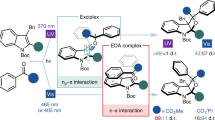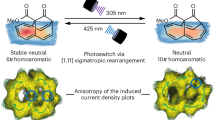Abstract
SUBSTITUENTS in a conjugated system do not always shift the absorption bands of the system in the one direction. If we consider only the absorption band of lowest frequency, then the most commonly observed effect is a shift to still lower frequencies1. However, Plattner and his co-workers2 found that alkyl groups sometimes shift the lowest-frequency band of azulene in the opposite direction. Brown and Lahey3 found a similar alternating effect of alkoxy groups in N-methylaeridone. They emphasized that these shifts could be correlated with the π-electron densities of azulene4 and N-methylacridone5 in accordance with the following rule: substituents attached to a position of (local) low π-electron density increase the frequency of the first absorption band, while in positions of high π-electron density the frequency is decreased. It is significant that substituents in alternant6 hydrocarbons, such as naphthalene, do not occasion these alternating effects1, and it is just for these systems that the molecular orbital approximation indicates a uniform electron density around the ring system6.
This is a preview of subscription content, access via your institution
Access options
Subscribe to this journal
Receive 51 print issues and online access
$199.00 per year
only $3.90 per issue
Buy this article
- Purchase on Springer Link
- Instant access to full article PDF
Prices may be subject to local taxes which are calculated during checkout
Similar content being viewed by others
References
Jones, R. N., J. Amer. Chem. Soc., 67, 2127 (1945).
Plattner, Pl. A., Helv. Chim. Acta, 24, 283E (1941). Plattner, Pl. A., and Heilbronner, E., Helv. Chim. Acta, 31, 804 (1948).
Brown, R. D., and Lahey, F. N., Austral. J. Sci. Res., A, 3, 593 (1950).
Coulson, C. A., and Longuet-Higgins, H. C., Rev. Sci., 85, 929 (1947). Brown, R. D., Trans. Farad. Soc., 44, 984 (1948).
Brown, R. D. (unpublished results).
Coulson, C. A., and Rushbrooke, G. S., Proc. Camb. Phil. Soc., 36, 193 (1940).
Miller, W. K., Knight, S. B., and Roe, A., J. Amer. Chem. Soc., 72, 1629 (1950).
Longuet-Higgins, H. C., and Coulson, C. A., Trans. Farad. Soc., 43, 87 (1947).
Pianka, M., Barany, H. C., and Smith, C. G., Nature, 167, 440 (1951).
Coulson, C. A., and Longuet-Higgins, H. C., Proc. Roy. Soc., A, 192, 16 (1947).
Plattner, Pl. A., et al., Helv. Chim. Acta, 34, 971 (1951).
Pullman, B., Mayot, M., and Berthier, G., J. Chem. Phys., 18, 257 (1950).
Dewar, M. J. S., J. Chem. Soc., 2329 (1950).
Coulson, C. A. (unpublished results).
Spiers and Wibaut, Rec. trav. chim., 56, 573 (1937).
Author information
Authors and Affiliations
Rights and permissions
About this article
Cite this article
BROWN, R. Effects of Substituents on Ultra-violet Absorption Spectra. Nature 169, 286–287 (1952). https://doi.org/10.1038/169286b0
Issue Date:
DOI: https://doi.org/10.1038/169286b0
Comments
By submitting a comment you agree to abide by our Terms and Community Guidelines. If you find something abusive or that does not comply with our terms or guidelines please flag it as inappropriate.



